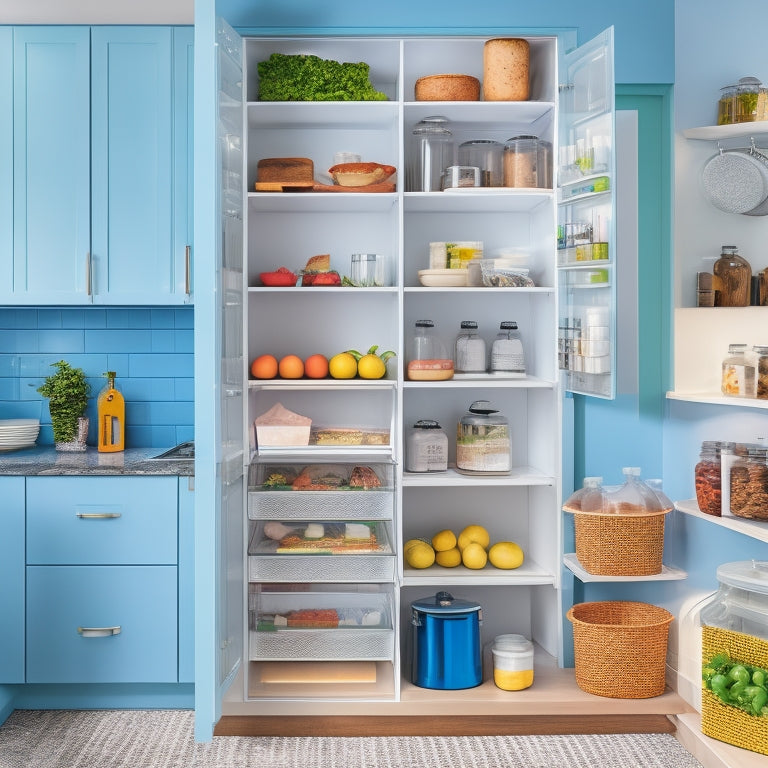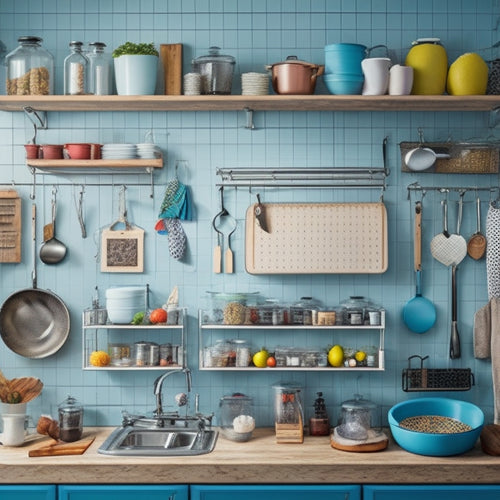
5 Best Kitchen Design Strategies for Dietary Needs
Share
You need a kitchen that accommodates your dietary requirements. To start, consider incorporating labeling stations and dedicated zones for gluten-free living. For a vegan-friendly space, opt for eco-friendly materials and energy-efficient appliances. When managing food allergies, prioritize easy cleaning and sanitation, and choose non-porous surfaces. Additionally, optimize your kitchen for special diets by catering to specific nutritional needs. Finally, utilize smart storage solutions to maximize your kitchen's capacity and organize specialized ingredients. By implementing these strategies, you'll be well on your way to creating a kitchen that supports your dietary needs - and there's more to explore!
Key Takeaways
• Designate specific cooking zones and labeling stations to prevent cross-contamination and ensure safe meal prep for gluten-free and food allergies.
• Incorporate thoughtful design elements, such as non-porous surfaces and easy-to-clean appliances, to accommodate special diets and optimize kitchen functionality.
• Utilize smart storage solutions, like adjustable shelving and corner cabinets, to maximize storage capacity and access to specialized ingredients.
• Create dedicated zones and implement labeling systems to cater to specific nutritional needs, such as vegan, kosher, and Low FODMAP diets.
• Choose eco-friendly materials, energy-efficient appliances, and sustainable storage solutions to create a vegan-friendly space that promotes a healthy lifestyle.
Designing for Gluten-Free Living
If you or a family member has gluten intolerance or sensitivity, designing a kitchen that accommodates gluten-free living is essential for maintaining a safe and healthy food environment. You'll want to create a space that minimizes cross-contamination and makes meal prep easy and stress-free.
To achieve this, consider incorporating labeling stations and dedicated zones into your kitchen design. Labeling stations can help you identify gluten-free ingredients and products, ensuring you're using the right items for your gluten-free meals.
Dedicated zones, such as a separate gluten-free pantry or cooking area, can prevent cross-contamination with gluten-containing foods.
Creating a Vegan-Friendly Space
As you design your kitchen to accommodate vegan dietary needs, you'll want to prioritize a space that effectively stores and prepares plant-based ingredients while minimizing waste and promoting sustainability. This means incorporating eco-friendly materials and energy-efficient appliances into your design.
A vegan aesthetic can be achieved through the use of natural materials, such as reclaimed wood and bamboo, and a color palette that features earthy tones.
When it comes to storage, consider investing in containers and bins made from sustainable materials to store your plant-based ingredients. You'll also want to make certain you have ample counter space for food preparation and cooking.
Plant-based cooking often requires more prep time, so a well-organized workspace is essential. Consider installing a large island or a butcher block countertop to provide additional space for chopping, dicing, and sautéing.
Accommodating Food Allergies Safely
When designing a kitchen that accommodates food allergies safely, you must prioritize a space that minimizes cross-contamination and guarantees easy cleaning and sanitation. This means choosing surfaces, appliances, and equipment that are easy to clean and resistant to harboring allergens.
For instance, opt for smooth, non-porous countertops and flooring, and consider a dishwasher with a sanitizing cycle.
Labeling systems are also essential in preventing cross-contamination. Clearly label storage containers, shelves, and cooking utensils to make sure that allergenic foods are kept separate from safe ones. This will help prevent accidental exposure and make it easier to identify potential risks.
Additionally, designate specific cooking zones and utensils for common allergens like peanuts, tree nuts, and gluten to further reduce cross-contamination risks.
Optimizing for Special Diets
You can create a kitchen that optimizes special diets by incorporating thoughtful design elements and clever storage solutions that cater to specific nutritional needs.
For instance, if you or a family member follows a kosher diet, consider installing separate cooking stations, sinks, and refrigerators to maintain the necessary segregation of meat and dairy products. Kosher considerations can also be incorporated into your kitchen design through the use of distinctive labeling and storage systems.
If you're managing irritable bowel syndrome (IBS) or other digestive issues, Low FODMAP solutions can be integrated into your kitchen design. This might include designated areas for fermenting and storing FODMAP-friendly foods, as well as clever storage for lactose-free or gluten-free alternatives.
Smart Storage for Restricted Diets
Incorporating smart storage solutions into your kitchen design can make a significant difference in managing restricted diets, allowing you to easily access and organize specialized ingredients and cooking essentials.
When you have specific dietary needs, maximizing your kitchen's storage capacity is crucial to accommodate unique items like gluten-free flours or allergy-friendly snacks.
You can achieve this by utilizing corner cabinets, which often go unused, to store infrequently used items. This frees up prime real estate in your kitchen for more frequently used items.
Adjustable shelving is another clever solution, enabling you to customize your storage space to fit your specific needs. For instance, you can adjust the shelves to accommodate different sizes of containers or cookbooks.
By incorporating these smart storage solutions, you'll be able to maintain a clutter-free kitchen, reducing stress and making meal prep more efficient.
With a well-organized kitchen, you'll feel more in control of your dietary needs, and cooking will become a more enjoyable experience.
Frequently Asked Questions
Can a Kitchen Be Designed for Multiple Dietary Needs at Once?
You can absolutely design a kitchen that accommodates multiple dietary needs simultaneously, leveraging Universal Design principles to create an Adaptive Space that's inclusive and flexible, catering to diverse requirements with ease.
How Do I Balance Aesthetics With Dietary Restrictions in Kitchen Design?
Imagine Sarah, a busy mom, struggling to create meals for her gluten-free daughter and vegan husband. You'll balance aesthetics with dietary restrictions by incorporating a cohesive style and functional fusion, like a stylish island with separate cooking stations.
Are There Any Specific Kitchen Layouts That Work Best for Dietary Needs?
You'll find that layouts prioritizing universal accessibility and adaptive workflow serve dietary needs best. Consider a U-shaped layout with ample counter space and a central island for effortless meal prep and cooking.
Can I Repurpose Existing Kitchen Elements for Dietary-Friendly Design?
"Like a master chef revamping a recipe, you can breathe new life into your kitchen by repurposing existing elements, such as a Cabinet Refresh or Countertop Swap, to create a dietary-friendly space that's both functional and fabulous."
What Role Does Lighting Play in Kitchen Design for Dietary Needs?
You're wise to take lighting into account in your kitchen design. Task lighting helps you prep and cook safely, while ambient moods create a welcoming atmosphere, making mealtime more enjoyable and inclusive for everyone.
Related Posts
-

Why Cluttered Kitchens Need Better Tool Storage
You're likely wasting around 30 minutes a day searching for misplaced kitchen tools or utensils, which is equivalent ...
-

Community Engagement: Learning Through Professions
Community engagement is a powerful tool for fostering a deeper understanding of various professions among children. B...

